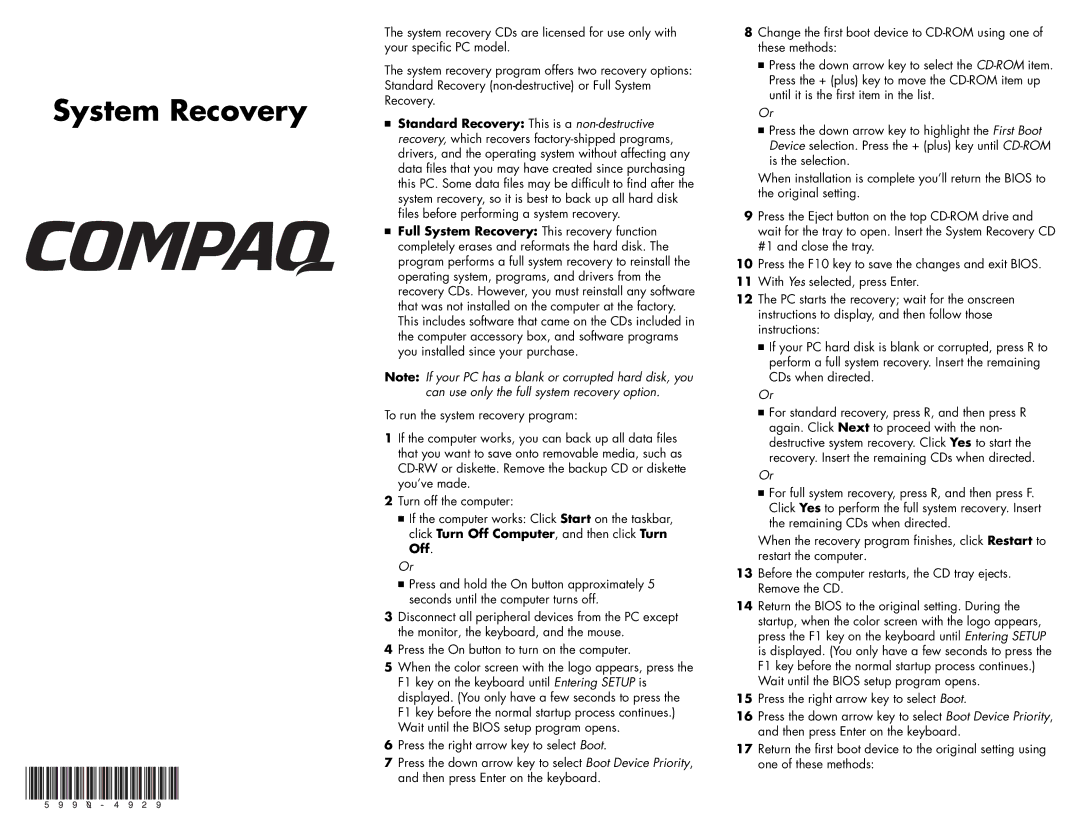
System Recovery
The system recovery CDs are licensed for use only with your specific PC model.
The system recovery program offers two recovery options: Standard Recovery
■Standard Recovery: This is a
■Full System Recovery: This recovery function completely erases and reformats the hard disk. The program performs a full system recovery to reinstall the operating system, programs, and drivers from the recovery CDs. However, you must reinstall any software that was not installed on the computer at the factory. This includes software that came on the CDs included in the computer accessory box, and software programs you installed since your purchase.
Note: If your PC has a blank or corrupted hard disk, you can use only the full system recovery option.
To run the system recovery program:
1If the computer works, you can back up all data files that you want to save onto removable media, such as
2Turn off the computer:
■If the computer works: Click Start on the taskbar, click Turn Off Computer, and then click Turn Off.
Or
■Press and hold the On button approximately 5 seconds until the computer turns off.
3Disconnect all peripheral devices from the PC except the monitor, the keyboard, and the mouse.
4Press the On button to turn on the computer.
5When the color screen with the logo appears, press the F1 key on the keyboard until Entering SETUP is displayed. (You only have a few seconds to press the F1 key before the normal startup process continues.) Wait until the BIOS setup program opens.
6Press the right arrow key to select Boot.
7Press the down arrow key to select Boot Device Priority, and then press Enter on the keyboard.
8Change the first boot device to
■Press the down arrow key to select the
Or
■Press the down arrow key to highlight the First Boot Device selection. Press the + (plus) key until
When installation is complete you’ll return the BIOS to the original setting.
9Press the Eject button on the top
10Press the F10 key to save the changes and exit BIOS.
11With Yes selected, press Enter.
12The PC starts the recovery; wait for the onscreen instructions to display, and then follow those instructions:
■If your PC hard disk is blank or corrupted, press R to perform a full system recovery. Insert the remaining CDs when directed.
Or
■For standard recovery, press R, and then press R again. Click Next to proceed with the non- destructive system recovery. Click Yes to start the recovery. Insert the remaining CDs when directed.
Or
■For full system recovery, press R, and then press F. Click Yes to perform the full system recovery. Insert the remaining CDs when directed.
When the recovery program finishes, click Restart to restart the computer.
13Before the computer restarts, the CD tray ejects. Remove the CD.
14Return the BIOS to the original setting. During the startup, when the color screen with the logo appears, press the F1 key on the keyboard until Entering SETUP is displayed. (You only have a few seconds to press the F1 key before the normal startup process continues.) Wait until the BIOS setup program opens.
15Press the right arrow key to select Boot.
16Press the down arrow key to select Boot Device Priority, and then press Enter on the keyboard.
17Return the first boot device to the original setting using one of these methods:
